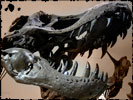National Geographic Channel
Dinosaurs
A Night of Dinosaur Discoveries
Dino Death Trap–Sunday, Dec. 9 at 8P et / 9P pt
Dino Autopsy–Sunday, Dec. 9 at 9P et / 10P pt

Dinosaur Death Traps
A Tabluea of Death—A Lost World Revealed
Imagine the dinosaurs and other prehistoric creatures of the mid-Jurassic–predators and prey–locked in the daily struggle of survival. Suddenly, a volcanic cataclysm–a dinosaur Pompeii–engulfs them. Some die in an instant. Others break for the safety of the horizon as hot ash rains down on surrounding wetlands. As they plow through the forming ashy mud, they are swallowed, as though by quicksand, frozen in death for 160 million years. Until now.
Today, in China’s western Gobi desert, paleontologists are uncovering what they believe to be the aftermath of this prehistoric cataclysm–pits of dinosaur fossils stacked four and five deep. Nothing like this has ever been seen before – a mass grave site of predatory dinos, including what scientists believe is the precursor to the most “terrible lizard”of them all–the Tyrannosaurus Rex.
More astounding still–these fossils are the missing puzzle-pieces from a long-lost era in dino history–the Middle Jurassic, a time when dinosaurs took over the world. It is in this hazy era that dinosaurs grew gigantic. But how they super-sized is one of the most electrifying questions in paleontology. These new fossils may hold a key to how dinosaurs grew to be the largest, most dominant life forms on the planet.

Can You Find the Fossils in Time?
Dig up matching bones in the Dino Death Pit to build a complete fossil before time runs out.
Play ‘Fossil Hunt’ »

3D ‘Death Trap’ Dino Profiles
See these doomed dinos in their death throes and explore interactive 3D profiles.
Launch 3D Dino Explorer »

Death Trap Dig
Learn more about this astounding fossil find and what killed these dinos 160 million years ago.
Watch Video »

Missing Dino History
What caused dinosaurs to super-size during the mid-Jurassic? Explore the gap in dino history.
Watch Video »

T. Rex’s Ancestor
Meet Guanlong–Chinese for “crested dragon.” This dino is fearsome T. Rex’s ancient relative..
Watch Video »
See more on “Dino Death Trap” from the National Geographic Channel
Find out about the show and watch a preview »
Explore 3D profiles of new dino species, watch videos about the find and play the ‘Fossil Hunt’ game.



